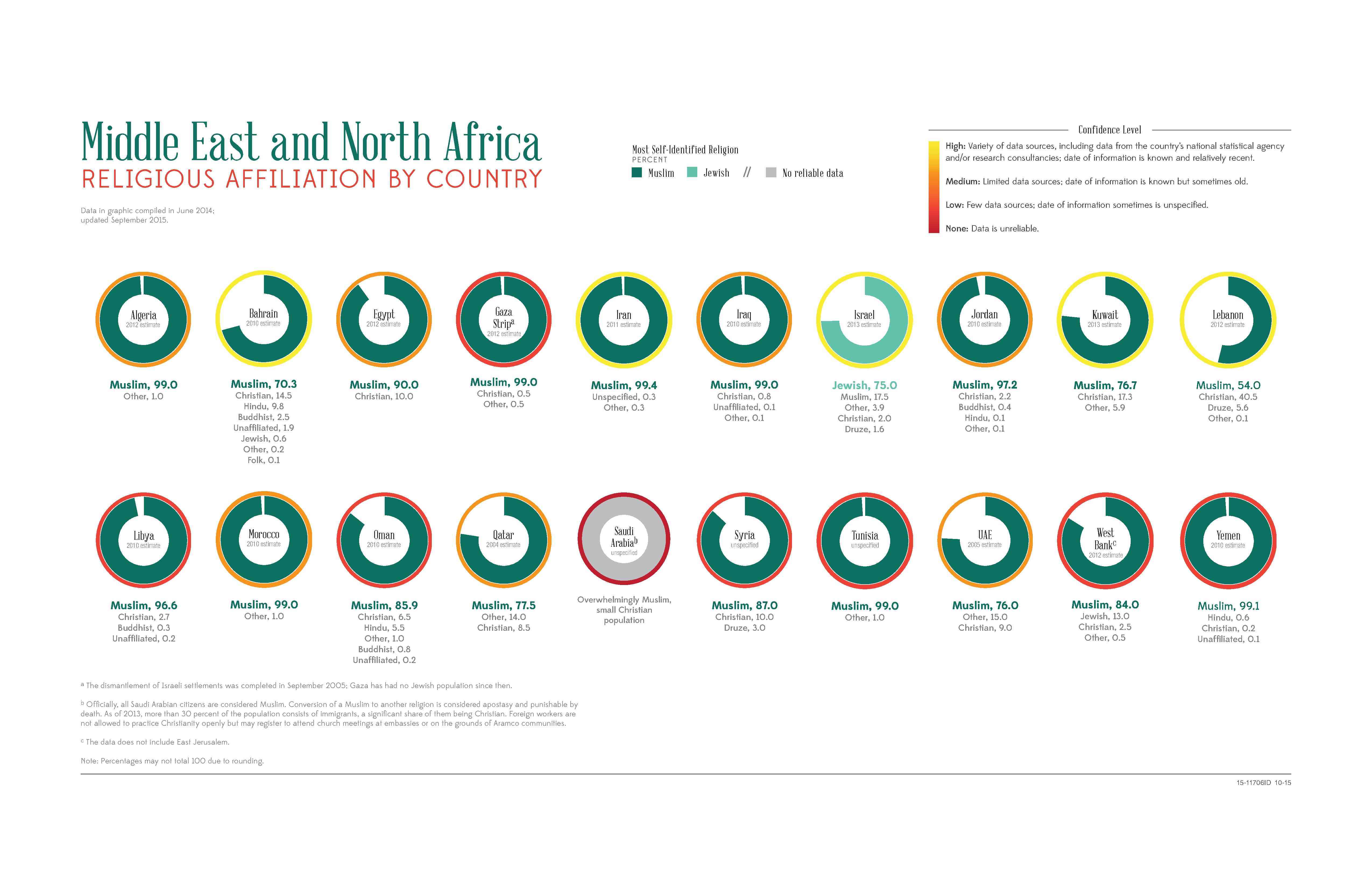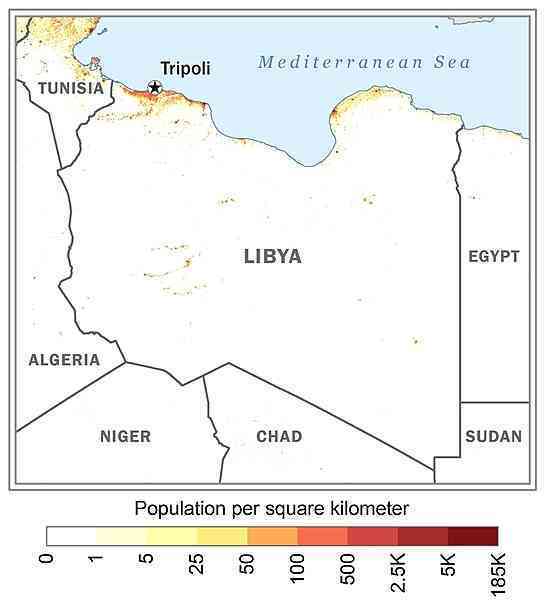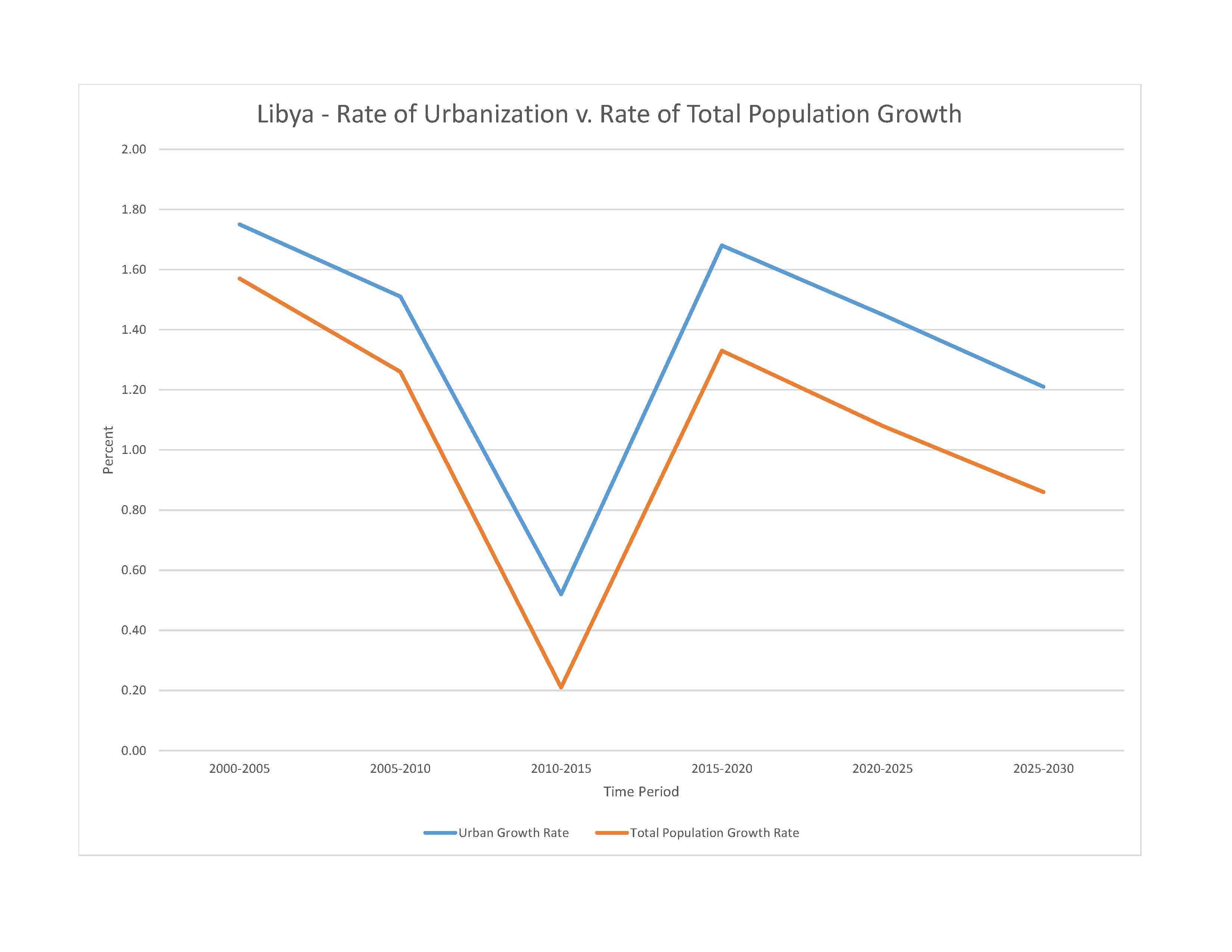
7,252,573 (2023 est.)
note: immigrants make up just over 12% of the total population, according to UN data (2019)
noun: Libyan(s)
adjective: Libyan
Amazigh and Arab 97%, other 3% (includes Egyptian, Greek, Indian, Italian, Maltese, Pakistani, Tunisian, and Turkish)
Arabic (official), Italian, English (all widely understood in the major cities); Tamazight (Nafusi, Ghadamis, Suknah, Awjilah, Tamasheq)
major-language sample(s):
كتاب حقائق العالم، المصدر الذي لا يمكن الاستغناء عنه للمعلومات الأساسية (Arabic)
The World Factbook, the indispensable source for basic information.
Arabic audio sample:
Muslim (official; virtually all Sunni) 96.6%, Christian 2.7%, Buddhist
note: non-Sunni Muslims include native Ibadhi Muslims (
Despite continuing unrest, Libya remains a destination country for economic migrants. It is also a hub for transit migration to Europe because of its proximity to southern Europe and its lax border controls. Labor migrants have been drawn to Libya since the development of its oil sector in the 1960s. Until the latter part of the 1990s, most migrants to Libya were Arab (primarily Egyptians and Sudanese). However, international isolation stemming from Libya’s involvement in international terrorism and a perceived lack of support from Arab countries led QADHAFI in 1998 to adopt a decade-long pan-African policy that enabled large numbers of Sub-Saharan migrants to enter Libya without visas to work in the construction and agricultural industries. Although Sub-Saharan Africans provided a cheap labor source, they were poorly treated and were subjected to periodic mass expulsions.
By the mid-2000s, domestic animosity toward African migrants and a desire to reintegrate into the international community motivated QADHAFI to impose entry visas on Arab and African immigrants and to agree to joint maritime patrols and migrant repatriations with Italy, the main recipient of illegal migrants departing Libya. As his regime neared collapse in 2011, QADHAFI reversed his policy of cooperating with Italy to curb illegal migration and sent boats loaded with migrants and asylum seekers to strain European resources. Libya’s 2011 revolution decreased immigration drastically and prompted nearly 800,000 migrants to flee to third countries, mainly Tunisia and Egypt, or to their countries of origin. The inflow of migrants declined in 2012 but returned to normal levels by 2013, despite continued hostility toward Sub-Saharan Africans and a less-inviting job market.
While Libya is not an appealing destination for migrants, since 2014, transiting migrants – primarily from East and West Africa – continue to exploit its political instability and weak border controls and use it as a primary departure area to migrate across the central Mediterranean to Europe in growing numbers. In addition, approximately 135,000 people were displaced internally as of August 2022 by fighting between armed groups in eastern and western Libya and, to a lesser extent, by inter-tribal clashes in the country’s south.
0-14 years: 32.81% (male 1,213,850/female 1,166,039)
15-64 years: 62.8% (male 2,340,685/female 2,213,782)
65 years and over: 4.39% (2023 est.) (male 143,737/female 174,480)
total dependency ratio: 50.8
youth dependency ratio: 43.5
elderly dependency ratio: 7.3
potential support ratio: 13.8 (2021 est.)
total: 26.1 years (2023 est.)
male: 26.1 years
female: 26.1 years
1.54% (2023 est.)
20.9 births/1,000 population (2023 est.)
3.5 deaths/1,000 population (2023 est.)
-2.1 migrant(s)/1,000 population (2023 est.)
well over 90% of the population lives along the Mediterranean coast in and between Tripoli to the west and Al Bayda to the east; the interior remains vastly underpopulated due to the Sahara and lack of surface water as shown in this 
urban population: 81.6% of total population (2023)
rate of urbanization: 1.45% annual rate of change (2020-25 est.)

1.183 million TRIPOLI (capital), 984,000 Misratah, 859,000 Benghazi (2023)
at birth: 1.05 male(s)/female
0-14 years: 1.04 male(s)/female
15-64 years: 1.06 male(s)/female
65 years and over: 0.82 male(s)/female
total population: 1.04 male(s)/female (2023 est.)
72 deaths/100,000 live births (2020 est.)
total: 11 deaths/1,000 live births (2023 est.)
male: 12.4 deaths/1,000 live births
female: 9.5 deaths/1,000 live births
total population: 77.4 years (2023 est.)
male: 75.2 years
female: 79.8 years
3.04 children born/woman (2023 est.)
1.48 (2023 est.)
27.7% (2014)
improved: urban: N/A
rural: N/A
total: 99.9% of population
unimproved: urban: N/A
rural: N/A
total: 0.1% of population (2020 est.)
N/A
2.09 physicians/1,000 population (2017)
3.2 beds/1,000 population (2017)
improved: urban: N/A
rural: N/A
total: 99.3% of population
unimproved: urban: N/A
rural: N/A
total: 0.7% of population (2020 est.)
32.5% (2016)
total: 0.01 liters of pure alcohol (2019 est.)
beer: 0 liters of pure alcohol (2019 est.)
wine: 0.01 liters of pure alcohol (2019 est.)
spirits: 0 liters of pure alcohol (2019 est.)
other alcohols: 0 liters of pure alcohol (2019 est.)
11.7% (2014)
59.2% (2023 est.)
N/A
definition: age 15 and over can read and write
total population: 91%
male: 96.7%
female: 85.6% (2015)
NOTE: The information regarding Libya on this page is re-published from the 2024 World Fact Book of the United States Central Intelligence Agency and other sources. No claims are made regarding the accuracy of Libya 2024 information contained here. All suggestions for corrections of any errors about Libya 2024 should be addressed to the CIA or the source cited on each page.
This page was last modified 04 May 24, Copyright © 2024 ITA all rights reserved.